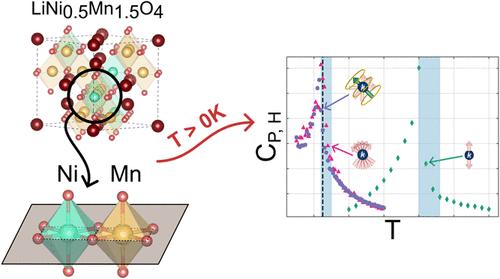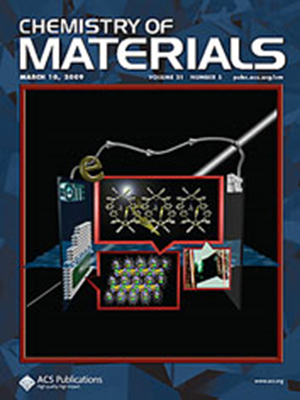First-Principles Statistical Mechanics Study of Magnetic Fluctuations and Order–Disorder in the Spinel LiNi0.5Mn1.5O4 Cathode
IF 7.2
2区 材料科学
Q2 CHEMISTRY, PHYSICAL
引用次数: 0
Abstract
While significant magnetic interactions exist in lithium transition metal oxides, commonly used as Li-ion cathodes, the interplay between magnetic couplings, disorder, and redox processes remains poorly understood. In this work, we focus on the high-voltage spinel LiNi0.5Mn1.5O4 (LNMO) cathode as a model system on which to apply a computational framework that uses first principles-based statistical mechanics methods to predict the finite temperature magnetic properties of materials and provide insights into the complex interplay between magnetic and chemical degrees of freedom. Density functional theory calculations on multiple distinct Ni–Mn orderings within the LNMO system, including the ordered ground-state structure (space group P4332), reveal a preference for a ferrimagnetic arrangement of the Ni and Mn sublattices due to strong antiferromagnetic superexchange interactions between neighboring Mn4+ and Ni2+ ions and ferromagnetic Mn–Mn and Ni–Ni couplings, as revealed by magnetic cluster expansions. These results are consistent with qualitative predictions using the Goodenough-Kanamori-Anderson rules. Simulations of the finite temperature magnetic properties of LNMO are conducted using Metropolis Monte Carlo. We find that a “semiclassical” Monte Carlo sampling method based on the Heisenberg Hamiltonian accurately predicts experimental magnetic transition temperatures observed in magnetometry measurements. This study highlights the importance of a robust computational toolkit that accurately captures the complex chemomagnetic interactions and predicts finite temperature magnetic behavior to help analyze experimental magnetic and magnetic resonance spectroscopy data acquired ex situ and operando.

求助全文
约1分钟内获得全文
求助全文
来源期刊

Chemistry of Materials
工程技术-材料科学:综合
CiteScore
14.10
自引率
5.80%
发文量
929
审稿时长
1.5 months
期刊介绍:
The journal Chemistry of Materials focuses on publishing original research at the intersection of materials science and chemistry. The studies published in the journal involve chemistry as a prominent component and explore topics such as the design, synthesis, characterization, processing, understanding, and application of functional or potentially functional materials. The journal covers various areas of interest, including inorganic and organic solid-state chemistry, nanomaterials, biomaterials, thin films and polymers, and composite/hybrid materials. The journal particularly seeks papers that highlight the creation or development of innovative materials with novel optical, electrical, magnetic, catalytic, or mechanical properties. It is essential that manuscripts on these topics have a primary focus on the chemistry of materials and represent a significant advancement compared to prior research. Before external reviews are sought, submitted manuscripts undergo a review process by a minimum of two editors to ensure their appropriateness for the journal and the presence of sufficient evidence of a significant advance that will be of broad interest to the materials chemistry community.
 求助内容:
求助内容: 应助结果提醒方式:
应助结果提醒方式:


